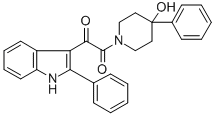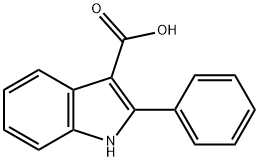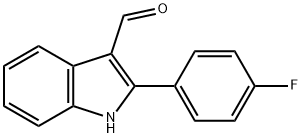2-PHENYLINDOLE-3-CARBOXALDEHYDE
Synonym(s):3-Formyl-2-phenylindole
- CAS NO.:25365-71-3
- Empirical Formula: C15H11NO
- Molecular Weight: 221.25
- MDL number: MFCD00435481
- SAFETY DATA SHEET (SDS)
- Update Date: 2023-04-23 13:52:06

What is 2-PHENYLINDOLE-3-CARBOXALDEHYDE?
The Uses of 2-PHENYLINDOLE-3-CARBOXALDEHYDE
Reactant for preparation of:
- Tryptophan dioxygenase inhibitors pyridyl-ethenyl-indoles as potential anticancer immunomodulators
- Pyrimidinones via Biginelli reaction as antimicrobial agents
- [(phenyl)pyrazolyl]indole derivatives as antiinflammatory agents and analgesics
- Indole thiophene chalcones via Claisen-Schmidt condensation as antimicrobial and antioxidant agents
- Benzofuranone attached indole derivatives as PI3K inhibitors
- Ionone-based chalcones as novel antiandrogens
- Oxazolylindoles as antiinflammatory agents for edema
What are the applications of Application
2-Phenylindole-3-carboxaldehyde is an important reactant for the synthesis of PI3K and tryptophan dioxygenase inhibitors
Properties of 2-PHENYLINDOLE-3-CARBOXALDEHYDE
| Melting point: | 249-253 °C (lit.) |
| Boiling point: | 462.9±33.0 °C(Predicted) |
| Density | 1.237±0.06 g/cm3(Predicted) |
| storage temp. | Inert atmosphere,Room Temperature |
| form | powder to crystal |
| pka | 15.30±0.30(Predicted) |
| color | White to Brown |
| Sensitive | Air Sensitive |
| CAS DataBase Reference | 25365-71-3(CAS DataBase Reference) |
Safety information for 2-PHENYLINDOLE-3-CARBOXALDEHYDE
| Signal word | Warning |
| Pictogram(s) |
 Exclamation Mark Irritant GHS07 |
| GHS Hazard Statements |
H315:Skin corrosion/irritation H319:Serious eye damage/eye irritation H335:Specific target organ toxicity, single exposure;Respiratory tract irritation |
| Precautionary Statement Codes |
P261:Avoid breathing dust/fume/gas/mist/vapours/spray. P264:Wash hands thoroughly after handling. P264:Wash skin thouroughly after handling. P271:Use only outdoors or in a well-ventilated area. P280:Wear protective gloves/protective clothing/eye protection/face protection. P302+P352:IF ON SKIN: wash with plenty of soap and water. P305+P351+P338:IF IN EYES: Rinse cautiously with water for several minutes. Remove contact lenses, if present and easy to do. Continuerinsing. |
Computed Descriptors for 2-PHENYLINDOLE-3-CARBOXALDEHYDE
New Products
Tert-butyl bis(2-chloroethyl)carbamate (S)-3-Aminobutanenitrile hydrochloride N-Boc-D-alaninol N-BOC-D/L-ALANINOL N-octanoyl benzotriazole 4-Hydrazinobenzoic acid 3,4-Dibenzyloxybenzaldehyde Electrolytic Iron Powder 1,1’-CARBONYLDIIMIDAZOLE R-2-BENZYLOXY PROPIONIC ACID 4-HYDROXY BENZYL ALCOHOL 1,1’-CARBONYLDI (1,2-4 TRIAZOLE) S-2-CHLORO PROPIONIC ACID (2-Hydroxyphenyl)acetonitrile 4-Bromopyrazole 5-BROMO-2CYANO PYRIDINE 5,6-Dimethoxyindanone 5-broMo-2-chloro-N-cyclopentylpyriMidin-4-aMine 3-(2,4-Dimethoxybenzyl)dihydropyrimidine-2,4(1H,3H)-dione 6-Bromo-3-iodo-1-methyl-1H-indazole 4-Ethylbenzylamine N-(5-Amino-2-methylphenyl)acetamide 2-(BOC-Amino)4-picoline 1-(4-Methylphenylsulfonyl)-1H-1,2,3-benzotriazoleRelated products of tetrahydrofuran
![5,11-dihydro-6H-indolo[3,2-c]quinolin-6-one](https://img.chemicalbook.in/CAS/GIF/18735-98-3.gif)







You may like
-
 2-Phenylindole-3-carboxaldehyde CAS 25365-71-3View Details
2-Phenylindole-3-carboxaldehyde CAS 25365-71-3View Details
25365-71-3 -
 100-71-0 99%View Details
100-71-0 99%View Details
100-71-0 -
 2 2-BIS(2-HYDROXYETHOXY)-1 1-BINAPHTHYL 99%View Details
2 2-BIS(2-HYDROXYETHOXY)-1 1-BINAPHTHYL 99%View Details
55441-95-7 -
 Chloro Uracil 1820-81-1 99%View Details
Chloro Uracil 1820-81-1 99%View Details
1820-81-1 -
 2-ethyl-6-methyl-3-hydroxypyridine succinate 127464-43-1 99%View Details
2-ethyl-6-methyl-3-hydroxypyridine succinate 127464-43-1 99%View Details
127464-43-1 -
 13162-05-5 N-Vinylformamide 99%View Details
13162-05-5 N-Vinylformamide 99%View Details
13162-05-5 -
 1446013-08-6 98%View Details
1446013-08-6 98%View Details
1446013-08-6 -
 Ste-Glu-AEEA-AEEA-OSUView Details
Ste-Glu-AEEA-AEEA-OSUView Details
1169630-40-3
Statement: All products displayed on this website are only used for non medical purposes such as industrial applications or scientific research, and cannot be used for clinical diagnosis or treatment of humans or animals. They are not medicinal or edible.